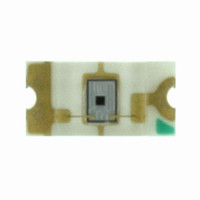LX1972IBC-TR Microsemi Analog Mixed Signal Group, LX1972IBC-TR Datasheet - Page 5

LX1972IBC-TR
Manufacturer Part Number
LX1972IBC-TR
Description
IC AMBIENT LIGHT DETECTOR 1206
Manufacturer
Microsemi Analog Mixed Signal Group
Datasheet
1.LX1972IBC-TR.pdf
(9 pages)
Specifications of LX1972IBC-TR
Wavelength
520nm
Output Type
Current
Package / Case
1206 (3216 Metric)
Lead Free Status / RoHS Status
Lead free / RoHS Compliant
Other names
LX1972IBCTR
Available stocks
Company
Part Number
Manufacturer
Quantity
Price
Company:
Part Number:
LX1972IBC-TR
Manufacturer:
HRS
Quantity:
397
Copyright © 2004
Rev. 1.1b, 2005-10-31
L
define the light source. Lux is a unit for the measurement
of illuminance, which is the photometric flux density or
visible light flux density.
measurement of irradiance or the measurement of
electromagnetic radiation, flux both visible and invisible.
The first step in the conversion process is to convert
irradiance to illuminance, which essentially involves
running the irradiant flux through a photopic filter. In
normal ambient, a photopic curve is used and in dark
ambient, a scotopic curve (dark adapted eye) is used. If
the light is composed of only one wavelength, a
conversion chart will tell the conversion factor to convert
µ
is used, the light spectrum of the irradiance must be
applied to the photopic filter to determine the resultant
illuminance.
normal light adapted human eye is 555nm, which
corresponds to yellowish-green light.
conversion factor is 683 Lux = 1W/m
Therefore 14.6
W/m2 to lux (lumens/m2). If more than one wavelength
IGHT UNITS
In converting from
TM
µ
The most sensitive wavelength for the
W/cm
2
11861 Western Avenue, Garden Grove, CA. 92841, 714-898-8121, Fax: 714-893-2570
µ
= 100 lux at 555nm.
W/cm
2
to lux it is necessary to
Whereas
S I M P L I F I E D B L O C K D I A G R A M
2
Current
At 555nm, the
= 100
µ
Amp
Figure 3 – Simplified Block Diagram
W/cm
A P P L I C A T I O N N O T E
Integrated Products Division
µ
W/cm
2
®
Microsemi
is a
2
.
produce the same output current for the same number of lux,
regardless of the color of the light. However, because the
match is not perfect, there is still wavelength dependency
particularly at the ends of the visible spectrum.
520nm, however depending on the light source, what the
human eye perceives as ‘white’ light may actually be
composed of peak wavelengths of light other than 520nm.
For instance, a typical fluorescent lamp includes dominant
light not only near 550nm but also at 404 and 435nm.
Incandescent light sources such as standard tungsten lights
generate substantial IR radiation out beyond 2000nm.
(automatic test equipment) light source is configured with
white LED’s whose current is adjusted to output a calibrated
flux density at 550nm. This allows consistent and repeatable
testing of the sensor but corresponds to a light source unlike
that typically found in a office, home or sunlit environment.
In practice, the user needs to place the sensor in the target
environment and calibrate the sensors output current range to
match the application objective. This is easily accomplished
by adjusting the output resistor, which sets the sensor’s gain.
If the photo sensor had a truly photopic response, it would
In the case of the LX1972 the peak photo response is at
For ease of automatic testing of the LX1972 the ATE
Ambient Light Detector
P
RODUCTION
S
PECIFICATION
VDD
VSS
LX1972
Page 5





















